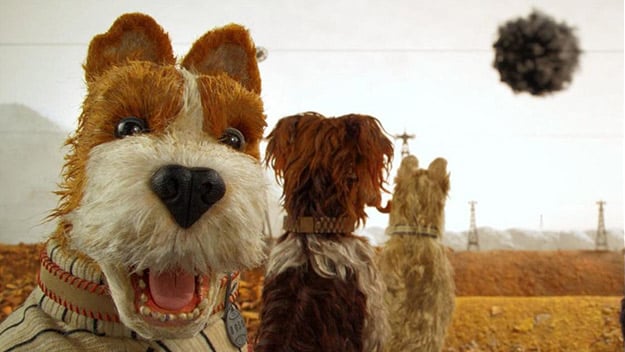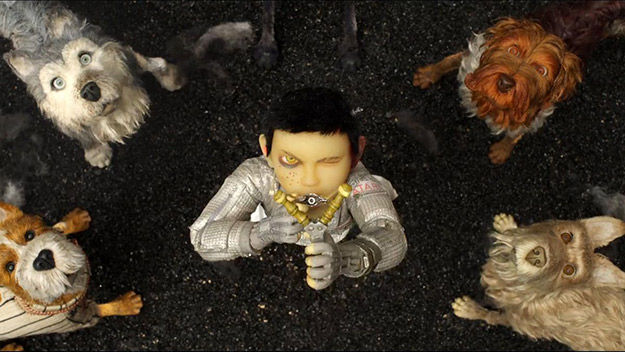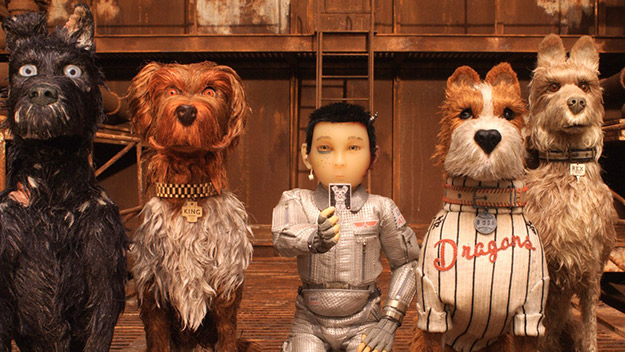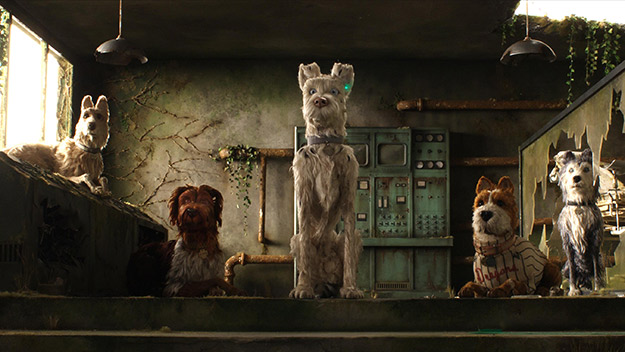Film of the Week: Isle of Dogs

No one would ever apply the term “extreme cinema” to Wes Anderson’s charming, increasingly whimsical confections. But if there was ever a cinema of excess, Anderson’s obsessively baroque films—overloaded with more detail than even the most manically attentive viewer could absorb—are surely it. His live-action films so far have never felt oppressive or airless: the vividness of his actors’ presence refuses to let his supremely artificed worlds become entirely mechanical, although Anderson sailed perilously close to the wind in the dollhouse universe of The Grand Budapest Hotel.
However, his stop-motion Fantastic Mr. Fox made it clear that animation is a mode which allows Anderson total control of a hyper-designed world, without having to worry too much about the chance elements that live-action involves, and without having actors impose too much of their living, breathing unpredictability on him. Fantastic Mr. Fox, exquisitely crafted as it was, now looks almost scrappy compared to the aesthetic brilliance and ambition of Isle of Dogs, which seemingly aims to set a new benchmark in cinema: most exhaustive compendium of visual styles in an animation ever, most densely crammed frames, most expressive yet determinedly non-cute funny animals.
Every image of Isle of Dogs is recognizably Anderson, yet the film sees him experimenting with different visual styles, clearing the air after The Grand Budapest Hotel, which seemed somewhat like a de luxe presentation box of the director’s best-loved tropes. For one thing, that trademark sans-serif font is replaced by a whole variety of lettering styles, Japanese and English. Anderson has refreshed himself by cramming voraciously on Japanese culture and visuals, modern and historical, and disgorging it all in an explosion of vibrantly heightened pop imagery. The setting is an entirely unreal dream Japan of 20 years hence, where Kobayashi (voiced by one of the story’s writers, Nomura Kunichi), mayor of apocryphal conurbation Megasaki, has declared war on all dogs, carriers of fleas and the dreaded “snout fever.” The city’s entire canine population is to be exiled to the nearby barren Trash Island, to fend for itself among garbage piles riddled with rats, maggots, and ticks (for once, some real ugliness and grit find their way into an Anderson world).

But the mayor and his cohorts, including Lurch-like henchman Major Domo, have faked the evidence against the dogs, for the cat-loving Kobayashi clan (a breathless illustrated prologue explains) have been at war with the once-free canines for centuries. Then his intrepid 12-year-old ward Atari (voiced by Rankin Koyu) flies to Trash Island in search of his beloved guard mutt Spots, the first dog to be exiled. Stranded there, he sets out on a voyage to find Spots, aided by an ostensibly fearsome pack of alpha mutts named King, Duke, Rex, and Boss. Ostensibly fearsome, that is, but really introspective and depressed, with laconically droll human voices to match: respectively, Bob Balaban, Jeff Goldblum, Edward Norton, and Bill Murray. Leading these erstwhile house pets is tough-as-nails stray Chief (Bryan Cranston), who’s bound to reveal his softer side eventually—especially when he conceives a Lady and the Tramp fondness for enigmatically seductive ex-show dog Nutmeg (Scarlett Johansson). In the meantime, Chief is ready to take on all comers, canine, human, or robot—and every scrap in this movie is enacted, Tex Avery–style, in a blur of flailing limbs emerging from bubbling clouds of cotton wool.
Given how controlled everything in Isle of Dogs is, one of the liveliest things about it—and here’s where the material used gets to express its own energies—is its way with textures. Those seething blobs of cotton wool, the little puffs of light fabric that stand in for puffs of laboratory dry ice, the way that the dogs’ fur constantly ripples as if blown in the wind, as the animators’ fingers manipulate the puppets frame by frame… Isle of Dogs is a film of such visual richness that you can’t help getting carried away just cataloguing its effects. Some that come to mind: the eerie, Max Ernst–ish landscapes of Trash Island’s further reaches, each with its own differently colored sky; the traffic light colors of a shelter made from sake bottles; the translucent waxiness of Atari’s face in close-up; the psychedelic burst of futurist effects in a science lab; a trompe l’oeil river sequence done with green glass or plastic; different drawn styles used for a wall of cave graffiti, or Kobayashi’s bazooka-style back tattoo; multiple magazine, newspaper, TV reports… The variants never stop coming. Particularly clever are the borrowings from Japanese art, notably Hokusai, whose Great Wave off Kanagawa—in terms of recognizability, Japan’s Mona Lisa—is used for a priceless visual pun that works precisely because it’s so literal.
Extremely artful too is the play between animation styles, with the stop-motion of the main narrative (under the direction of Mark Waring) constantly set off against drawn animation by Gwenn Germain (an up-and-coming talent who made his reputation with his tributes to Hayao Miyazaki). In particular, stop-motion characters who appear on TV do so in drawn form: thus, one shot will give us a pipe-smoking newsreader in both his stop-motion puppet incarnation and in cartoon form on a TV screen. Another version of this comic disjunction is the film’s play with language: spoken Japanese, of which there’s rather a lot, is largely left unsubtitled bar the odd jokily discreet caption, although English-speaking interpreters, notably one voiced by Frances McDormand, occasionally intervene. As for the dogs, their barks—a caption tells us—have been translated into English.

Inevitably, if you’re not constitutionally attuned to Anderson’s aesthetic, you may feel that there are no substantial emotional rewards to be gained beyond the surfaces meticulously crafted by designers Adam Stockhausen and Paul Harrod, and photographed by DP Tristan Oliver to dizzily highlight the playoff between 2D and 3D space. And then again… The film’s characterful comic beats are without a single shred of mawkishness—full marks to Anderson for eschewing the Japanese cult of kawaii or cuteness. But once in a while, there’s just a touch of emotion sneaked in via the eyes: staring, seemingly blank glass orbs, in which at certain telling moments, a little pool of liquid will well up.
It comes across as a joke on Anglophone viewers’ impatience with other tongues that, when meeting the Japanese-speaking Atari, Chief comments, “I wish somebody could speak his language.” A question hanging over Isle of Dogs, of course, is how well Anderson speaks the language—the cultural language, that is—of Japan. Along with Roman Coppola and Jason Schwartzman, there is one Japanese co-writer credited with story: Nomura Kunichi, who voices Kobayashi, and who also appeared in Sofia Coppola’s Lost of Translation, a film that has increasingly been considered an insensitive representation of Japan as a manic, superficial culture of display. Isle of Dogs too has faced charges of insensitivity and cultural appropriation—notably by Justin Chang in his Los Angeles Times review.
An important point he makes, and one has to agree, is the prominent role played by a young American exchange student, Tracy Walker (Greta Gerwig), who aggressively becomes the de facto leader of a Japanese student action group, and is seen shouting down a Japanese scientist (named Yoko Ono, and played by Yoko Ono). You imagine that it was felt at some point that Western audiences would need a forceful white human character as a point of contact, yet Tracy comes across as an abrasive, intrusive, and not terribly entertaining figure whose narrative necessity is never apparent: the film doesn’t do much with her status as an outsider discovering Japan, and in any case the theme of mutual discovery is taken care of by the interplay between Atari and the dogs.

Tracy is certainly the irritant factor in a film that otherwise had me persuaded that Anderson had thought about his cultural references, and their meanings, as adequately as one would hope. Chang anticipates the counter-argument that the film isn’t really set in Japan at all but in Wes Anderson Land, which is true; indeed, it’s no more set there than was Gilbert and Sullivan’s comic opera The Mikado, two Englishmen’s imagining of Japan constructed from scraps of sketchy, newly acquired knowledge and transmuted into something bright, strange, and largely unanchored from the original (and racist? well, certainly). But The Mikado was created in 1885, and Anderson would have no excuse for producing a text similarly cobbled together from scrambled, fuzzily-received signals.
Anderson has been guilty of insensitivity before: The Darjeeling Limited is barely watchable in the way that it uses India as a mere backdrop, and its population as obliging extras, for the emotional travails of three self-absorbed American tourists. By contrast, the degree of Anderson’s attention to Japanese culture—whether it’s the tradition of woodblock art, or the allusions to Kurosawa’s urban movies like High and Low, or the taiko drumming that’s the basis for Alexandre Desplat’s witty, propulsive score—all suggests at least a wholehearted, respectful enthusiasm for engaging with Japanese culture. On the other hand, yes, you could say that Japan is reduced to visual furniture, that everything here is entirely transmuted into the stuff of pure Andersonism. Besides, why not choose a Japanese composer rather than a Western pasticheur, no matter how brilliant—or is it that pastiche, rather than anything resembling authenticity, is the whole point?
These are delicate, awkward questions, given that this is a film that thematically comes across—insofar as anything in an Anderson film can register as heartfelt—as a protest against intolerance and racial hatred. Other contemporary themes, meanwhile, notably political corruption and the engineering of falsehoods, come to mind not least because the oversized demagogue Kobayashi is unmistakably Trump-shaped in his general outline. From a political perspective, it may be inadequate to defend Isle of Dogs on purely cinematic grounds, but let’s do that anyway. It’s a film of dazzling wit, visual flair, and invention, crafted on a level so far above the routine illusionistic perfectionism of most contemporary Hollywood spectacle that you come out buzzing as if—and forgive me if I add my own final dash of cultural appropriation—you’ve just enjoyed a heady shot of visual and comedic wasabi.
Jonathan Romney is a contributing editor to Film Comment and writes its Film of the Week column. He is a member of the London Film Critics Circle.




